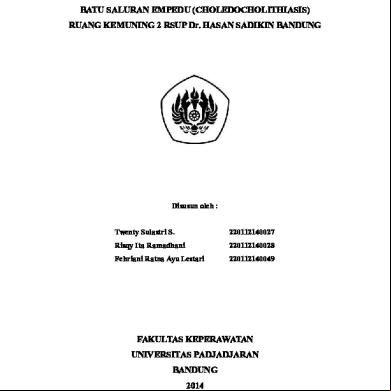Choledocholithiasis Pathophysiology 6zn6l
This document was ed by and they confirmed that they have the permission to share it. If you are author or own the copyright of this book, please report to us by using this report form. Report 3b7i
Overview 3e4r5l
& View Choledocholithiasis Pathophysiology as PDF for free.
More details w3441
- Words: 280
- Pages: 2
X. PATHOPHYSIOLOGY CHOLEDOCHOLITHIASIS Non Modifiable - Age: 58 years old
Modifiable - Diet: High fatty foods and alcohol intake - Lack of physical activity
Bile becomes supersaturated with cholesterol/calcium/excess unconjugated bilirubin/both and has decrease bile salt Solutes precipitate from solution to solid crystals Crystals come together to form stones Small stones may from the gall bladder to common bile duct Tx: - Cholecystomy Intraoperative Cholangiogram - T-tube insertion - Exploration of the Bile duct
Body tries to dislodge the stones Spasm of the biliary tracts S/Sx: - Biliary colic - RUQ pain
Obstruction in the common bile duct
No bile reaches the GIT
decreased bile in small intestine for fat digestion decreased emulsification of fats S/Sx: - Nausea and vomiting
decrease bile in duodenum
Backflow of conjugated bilirubin to liver Conjugated bilirubin enters blood stream
decreased Sterobilin S/Sx: - Clay-colored stool
S/Sx: - Jaundice - Icterus Sclera - Yellow skin
X. PATHOPHYSIOLOGY
Elevated intramural pressure Walls of the biliary tract becomes distended/inflammation occurs Occlusion of lymphatic channels then the venous return and arterial supply to the biliary tract becomes undermined
Diminished host antibacterial defenses Immune system dysfunction Bacteria form access to the biliary tree
Reduced blood supply to the biliary tract Decrease oxygenation Walls of the biliary tract starts to break
Bacteria starts to multiply
Bacteremia
Retro gate ascends from duodenum to the hepatic ducts S/Sx: - Charcot’s triad: Fever. RUQ pain, and Jaundice - Reynold’s pentad: Altered mental status, Hypotension, Fever. RUQ pain, and Jaundice
Symbols: Leads to : Diagnostics : Signs and Symptom : Patient based :
Bold Letter
References: http://emedicine.medscape.com/article/774245-overview#a5 Brunner and Suddarth’s Textbook of Medical-Surgical Nursing, Twelfth Edition Essentials of Anatomy and Physiology, Sixth Edition
Modifiable - Diet: High fatty foods and alcohol intake - Lack of physical activity
Bile becomes supersaturated with cholesterol/calcium/excess unconjugated bilirubin/both and has decrease bile salt Solutes precipitate from solution to solid crystals Crystals come together to form stones Small stones may from the gall bladder to common bile duct Tx: - Cholecystomy Intraoperative Cholangiogram - T-tube insertion - Exploration of the Bile duct
Body tries to dislodge the stones Spasm of the biliary tracts S/Sx: - Biliary colic - RUQ pain
Obstruction in the common bile duct
No bile reaches the GIT
decreased bile in small intestine for fat digestion decreased emulsification of fats S/Sx: - Nausea and vomiting
decrease bile in duodenum
Backflow of conjugated bilirubin to liver Conjugated bilirubin enters blood stream
decreased Sterobilin S/Sx: - Clay-colored stool
S/Sx: - Jaundice - Icterus Sclera - Yellow skin
X. PATHOPHYSIOLOGY
Elevated intramural pressure Walls of the biliary tract becomes distended/inflammation occurs Occlusion of lymphatic channels then the venous return and arterial supply to the biliary tract becomes undermined
Diminished host antibacterial defenses Immune system dysfunction Bacteria form access to the biliary tree
Reduced blood supply to the biliary tract Decrease oxygenation Walls of the biliary tract starts to break
Bacteria starts to multiply
Bacteremia
Retro gate ascends from duodenum to the hepatic ducts S/Sx: - Charcot’s triad: Fever. RUQ pain, and Jaundice - Reynold’s pentad: Altered mental status, Hypotension, Fever. RUQ pain, and Jaundice
Symbols: Leads to : Diagnostics : Signs and Symptom : Patient based :
Bold Letter
References: http://emedicine.medscape.com/article/774245-overview#a5 Brunner and Suddarth’s Textbook of Medical-Surgical Nursing, Twelfth Edition Essentials of Anatomy and Physiology, Sixth Edition





